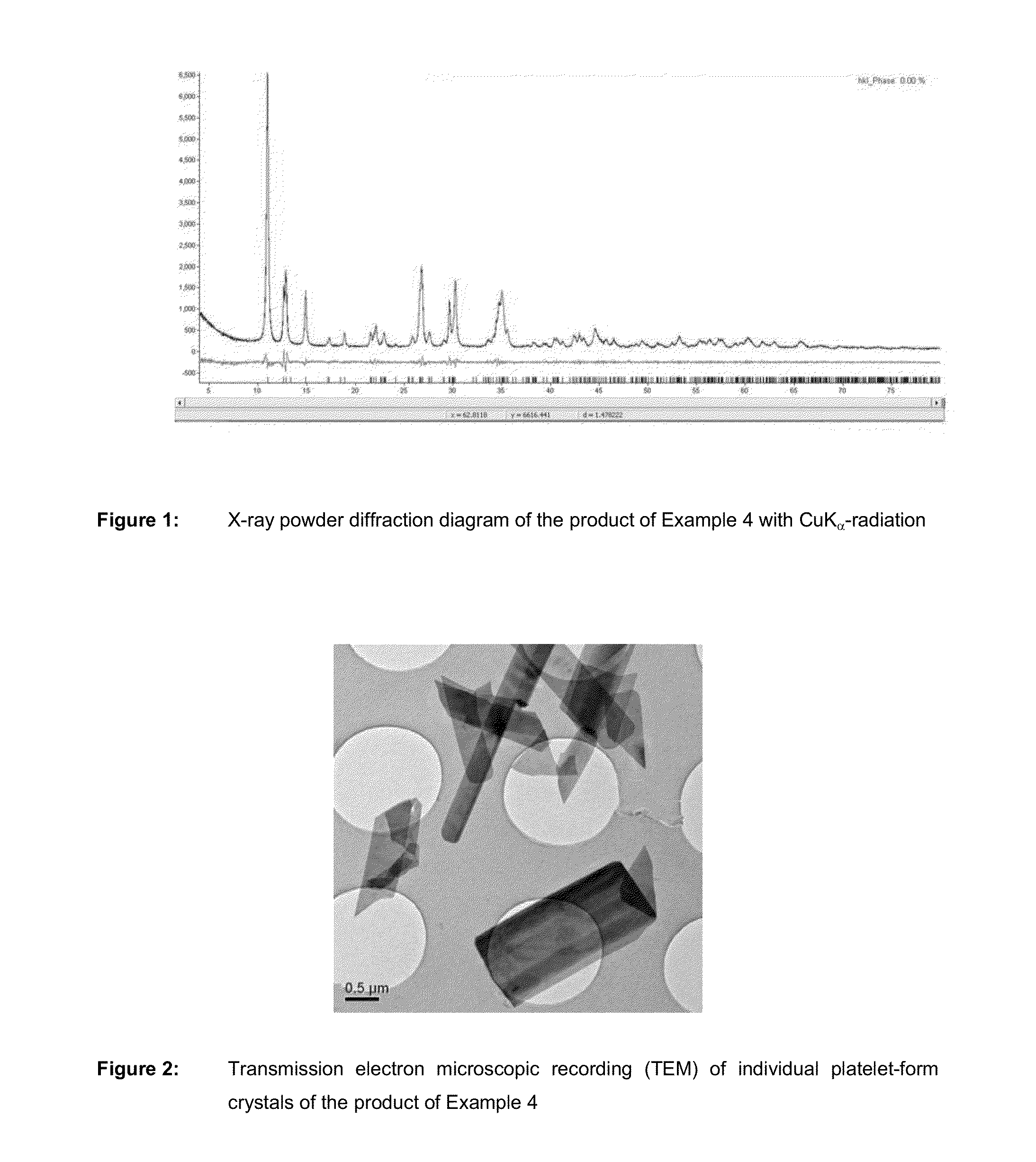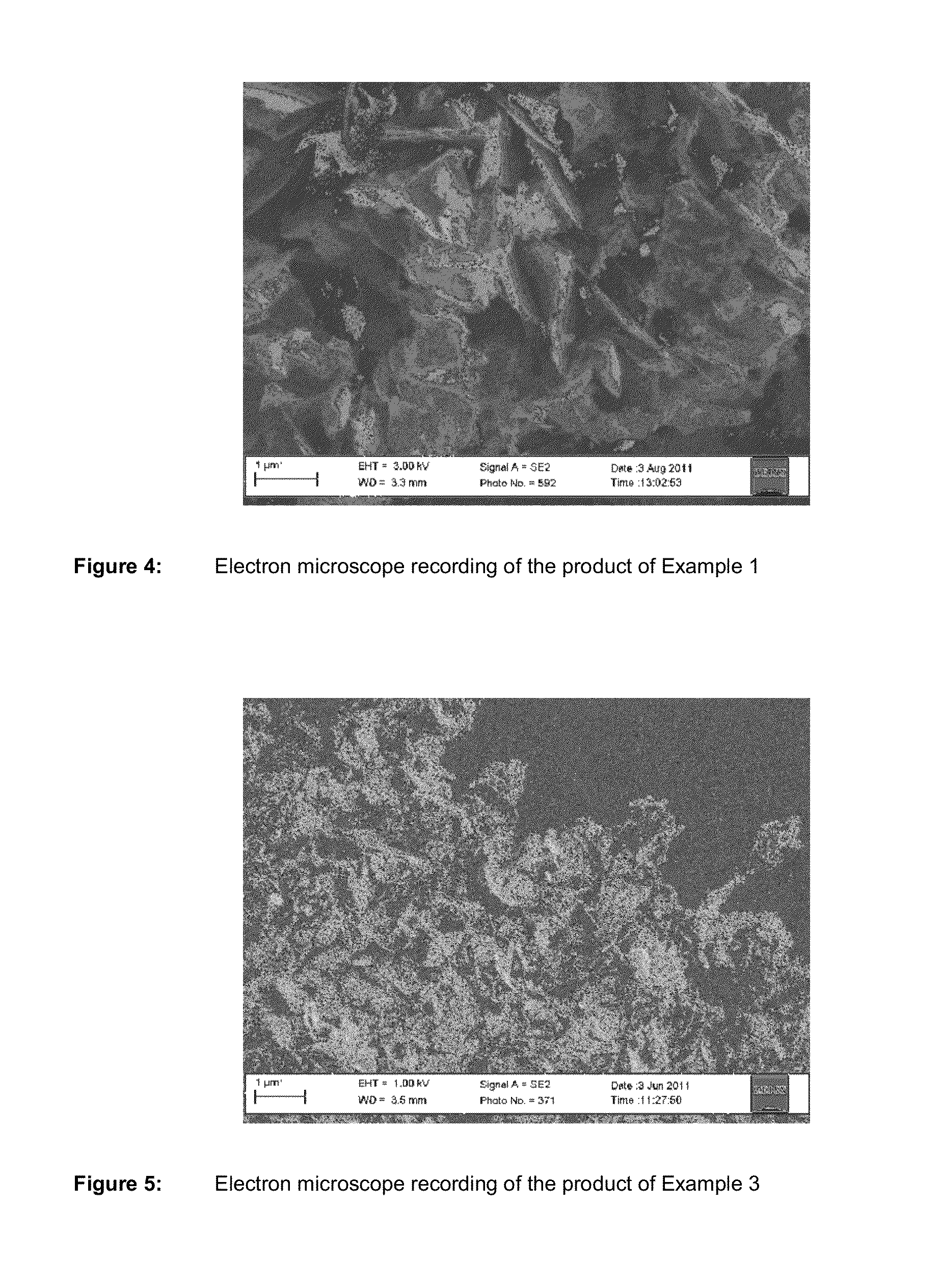Metal phosphate containing manganese and method for its production
- Summary
- Abstract
- Description
- Claims
- Application Information
AI Technical Summary
Benefits of technology
Problems solved by technology
Method used
Image
Examples
example 1
[0071]A phosphoric-acid solution (I) was produced from 80 g of 75% H3PO4 and 160 g of deionised water. 14.3 g of Mn3O4 and 3.5 g of Fe were added to that solution (I). The solution (I) was agitated for 90 minutes at room temperature and then filtered to remove from the solution residues which possibly remain.
[0072]A basic solution was also produced from 40 g of NaOH and 1000 g of deionised water. 25 g of H3PO4 with 100 g of water was placed in a reaction vessel and neutralised with the basic solution to a pH-value of 7, acquiring the receiver solution (II). The phosphoric-acid Me2+-solution (I) and the basic solution were meteredly added to the neutralised receiver solution (II) at the same time with agitation so that the pH-value of the receiver solution (II) was always kept between 6.5 and 7. After termination of the metered addition the solution was agitated for a further 5 minutes. The precipitated solid was then sucked away by means of a Nutsche filter and washed with deionised...
example 2
[0073]A phosphoric-acid solution (I) was produced from 230 g of 75% H3PO4 and 460 g of deionised water. 8.9 g of MnO2 as well as 30.1 g of Mn3O4 and 13.1 g of Fe were added to that solution (I). The solution (I) was agitated for 60 minutes at room temperature and then filtered to remove from the solution residues which possibly remain.
[0074]A basic solution was also produced from 120 g of NaOH and 3000 g of deionised water. 25 g of H3PO4 with 100 g of water was placed in a reaction vessel and neutralised with the basic solution to a pH-value of 7, acquiring the receiver solution (II). The phosphoric-acid Me2+-solution (I) and the basic solution were meteredly added to the neutralised receiver solution (II) at the same time with agitation so that the pH-value of the receiver solution (II) was always kept between 6.5 and 7. After termination of the metered addition the solution was agitated for a further 5 minutes. The precipitated solid was then sucked away by means of a Nutsche filt...
example 3
[0075]A phosphoric-acid solution (I) was produced from 80 g of 75% H3PO4 and 160 g of deionised water. 14.3 g of Mn3O4 and 3.8 g of Co were added to that solution (I). The solution (I) was agitated for 60 minutes at 60° C. and then filtered to remove from the solution residues which possibly remain.
[0076]A basic solution was also produced from 40.4 g of NaOH and 229 g of water. 25 g of H3PO4 with 100 g of water was placed in a reaction vessel and neutralised with the basic solution to a pH-value of 7, acquiring the receiver solution (II). The phosphoric-acid Me2+-solution (I) and the basic solution were meteredly added at the same time with agitation so that the pH-value of the receiver solution (II) was always kept between 6.5 and 7. After termination of the metered addition the solution was agitated for a further 5 minutes. The precipitated solid was then sucked away by means of a Nutsche filter and washed with deionised water. The filter cake was dried at 70° C. in a circulating ...
PUM
 Login to View More
Login to View More Abstract
Description
Claims
Application Information
 Login to View More
Login to View More - R&D
- Intellectual Property
- Life Sciences
- Materials
- Tech Scout
- Unparalleled Data Quality
- Higher Quality Content
- 60% Fewer Hallucinations
Browse by: Latest US Patents, China's latest patents, Technical Efficacy Thesaurus, Application Domain, Technology Topic, Popular Technical Reports.
© 2025 PatSnap. All rights reserved.Legal|Privacy policy|Modern Slavery Act Transparency Statement|Sitemap|About US| Contact US: help@patsnap.com



